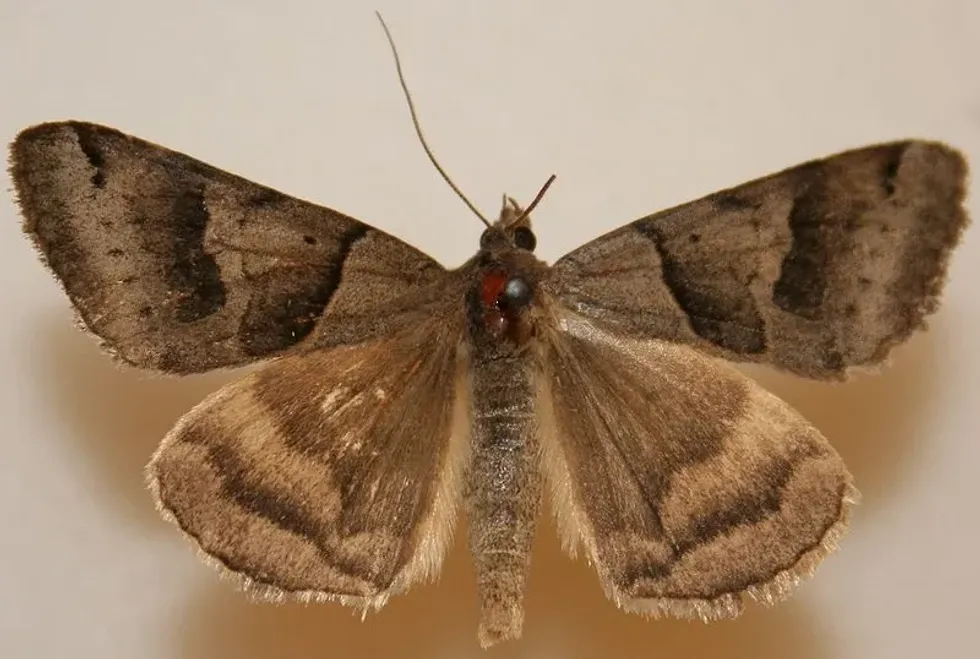Are you looking for a species of moth that can be found all across the United States? Then you must read about the forage looper moth.
Part of the Erebidae family of moths, forage loopers are often confused with another similar moth, the clover looper. Both these insects belong to the same genus, with the scientific name of forage looper being Caenurgina erechtea, and that of clover looper being Caenurgina crassiuscula.
The forage looper has a host of other different scientific names that act as synonyms.
They are Phalaena erechtea, Drasteria agricola, Drasteria mundula, Poaphila narrate, Caenurgina parva, and Poaphila patibilis. These insects are known to feed on clover and alfalfa while being active during the day and at night.
So, if you want to learn more about the forage looper moth and about how to identify them, scroll down and read on. For similar content on our website, take a look at the white admiral butterfly and the monarch butterfly.
Forage Looper Interesting Facts
What type of animal is a forage looper?
The forage looper (Caenurgina erechtea) is a moth that is widespread and abundant on the map of North America. Also known as common grass moths or grass looper moths, these moths can sometimes be confused with similar species like the clover looper (Caenurgina crassiuscula) leading to incorrect identification.
What class of animal does a forage looper belong to?
For its scientific classification, the forage looper moth (Caenurgina erechtea) is part of the class Insecta or insect and the phylum Arthropoda. Additionally, the forage looper moth family Erebidae is the one to which moths like the banded tussock moth and the gypsy moth belong.
This insect species falls under the order Lepidoptera, which houses all species of butterflies and moths. The order Lepidoptera is considered the most widely distributed insect order with over 180,000 species under this umbrella.
The forage looper moth (C. erechtea) belongs to the genus Caenurgina. Similar species in this genus include the Caenurgina crassiuscula or the clover looper moth. These adults are very similar in length, color, and distribution, making it difficult to differentiate them during identification.
How many forage loopers are there in the world?
Due to the abundant distribution of the species, it is extremely difficult to estimate their exact population. What also makes them difficult to count is that there can be countless generations of this genus Caenurgina moth in one year.
This is one of the reasons why the Caenurgia erechtea hasn't been evaluated by any major conservation organizations like the International Union For Conservation Of Nature (IUCN ).
Where does a forage looper moth live?
Forage looper moths (C. erechtea) are widespread across the map of North America. On the northwest side of the continent, they are found in certain provinces of Canada like Alberta and British Columbia.
Apart from Canada, it is common to catch these insects flying around all across the map of the United States of America, especially in places like Wisconsin, South Carolina, Minnesota, South Dakota, North Dakota, Idaho, and Michigan. Forage looper moths have also been noticed in places like Mexico, Hawaii, and Alaska.
What is a forage looper's habitat?
The forage looper moth is mainly seen inhabiting clover fields where they feed with the clover looper moth (Caenurgina crassiuscula). Other areas of habitat include moist meadows, roadsides, and fields with a lot of grasses. These insects can also sometimes venture into urban areas. The elevation range this insect can survive in ranges from high altitudes to low altitudes.
Interestingly, this insect species has been observed to be active both during day and night, with adults being attracted to places with light. However, when the moth is a caterpillar, it stays hidden during the day and only feeds on clover and grasses at night.
Who do forage loopers live with?
While moths and butterflies do lay their eggs in batches, these species are generally solitary after they hatch. This is also true for the forage looper caterpillar and moth. It is common to observe that these moths lead solitary lives and they can be seen in pairs only when breeding during a particular time of the year.
How long does a forage looper live?
Like most other moths such as the clover looper moth, forage looper moths do not have a long lifespan once they turn into adult moths. Belonging to the phylum Arthropoda, these forage looper moths can be assumed to have a short lifespan. Unfortunately, however, there isn't any information that can guide us to the exact age of this species.
How do they reproduce?
Unfortunately, there is a dearth of data regarding the reproduction of adult males and females within the forage looper moth ranks. However, we can confirm from available resources, that these moths can raise several broods from late spring (March to April) to the end of autumn in November.
The larvae start to pupate in November to develop into moths over the winter.
What is their conservation status?
As a result of their abundance, the forage looper moth hasn't been evaluated by any major conservation organizations that classify animals. The availability of habitats like fields full of grasses and food like clover has contributed to the expansion of their numbers through North America. For the forage looper moth, environmental factors haven't played a major role yet.
Forage Looper Fun Facts
What do forage loopers look like?
This insect usually has brown, white, gray, and black colors on its body. Females are slightly bigger and have different color shades than an average adult male.
In general, the forewing on males is light blue and gray, with the ends being darker grayish-brown. There are spots on their wings, with two brown bands on the forewing area. For females, the forewing color is light brown or red. On the hindwings of the forage looper moth, orange is the coloration in females and grayish-yellow in males.
How cute are they?
These forage looper moths are somewhat cute, but they aren't as beautiful as some species of butterflies.
How do they communicate?
We do not know how the forage looper moth communicates, but we can presume that they do so through sounds and the release of pheromones.
How big is a forage looper?
The length of the moth varies from 0.67-0.91 in (17-23 mm) with a wingspan of 1.18-1.65 in (30-42 mm). Thus, they are around four to five times smaller than the luna moth and the puss moth.
How fast can forage loopers fly?
There isn't data available to guide us regarding how fast these insects can fly.
How much does a forage looper weigh?
Like most other moth species, the weight of the forest looper is negligible.
What are the male and female names of the species?
There are no specific male and female names for the forage looper moth.
What would you call a baby forage looper?
The general guide to the different life stages of a moth states that a young moth should be called a caterpillar or a larva.
What do they eat?
Usually, the forage looper moth food menu consists of clover, alfalfa, and grasses. During the larva stage, the other food item on their menu is the giant ragweed.
Are they harmful?
No, these insects aren't harmful at all unless they are eaten.
Would they make a good pet?
As forage looper moths are used to living in the wild, it is not a good option to have them as pets. You should not keep them unless you can recreate a perfect forage looper moth environment within a glass enclosure.
Did you know...
During identification, you can differentiate between the clover looper and forage looper based on their color and patterns on the forewing.
The caterpillar of this moth has a white inner stripe bordered with a pale black-brown or tan stripe and an outer white stripe on the upper middle part of their body.
The forage looper is also called the common grass moth.
Is a forage looper moth beneficial or a pest?
Even though they usually stay in the wild, the forage looper moth can be a pest. You can clear them out by sending certain sound waves with the help of pest control.
How do you identify a forage looper moth?
You can identify a forage looper moth through the patterns and coloration on its wings and body!
Here at Kidadl, we have carefully created lots of interesting family-friendly animal facts for everyone to discover! For more relatable content, check out these ghost moth facts and black witch facts for kids.
You can even occupy yourself at home by coloring in one of our free printable butterfly coloring pages.









